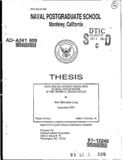An analysis of an eddy-resolving global ocean model in the tropical Indian Ocean
| dc.contributor.advisor | Semtner, Albert J. Jr. | |
| dc.contributor.author | Long, Erik Christopher | |
| dc.date.accessioned | 2013-11-20T23:33:46Z | |
| dc.date.available | 2013-11-20T23:33:46Z | |
| dc.date.issued | 1990 | |
| dc.identifier.uri | https://hdl.handle.net/10945/37565 | |
| dc.description.abstract | This paper examines the Semtner/Chervin global ocean model in the tropical Indian Ocean. The primitive equation, eddy-resolving model covers a domain from 75 deg S to 65 deg N at a horizontal resolution of 1/2 deg, with 20 vertical levels. In a new phase of an ongoing simulation, the wind stress has been changed from annual mean wind forcing to seasonal forcing, using the Hellerman/Rosenstein (1983) wind stress. The model is shown to reproduce the seasonal features of the Indian Ocean circulation. The model simulates the seasonally-reversing Somali Current, and includes seasonal undercurrents and a two-gyre system during the southwest monsoon. Westward flow occurs beneath the Southwest Monsoon Current during June and July. The major equatorial currents of the two monsoon regimes are well-represented, including semiannual Wyrtki jets and the Equatorial Undercurrent. Seasonal features of the marginally-resolved Leeuwin Current are present in the model. Monthly mass transports have been calculated for the major equatorial currents, as well as the Pacific-Indonesian throughflow, and are consistent with observations. The structure of deep equatorial jets in the model is highly baroclinic; an upward tilt in the jets from west to east accounts for simultaneous westward and upward phase propagation of the zonal velocity. The Haney (1971) method of prescribing surface heat flux is analyzed by comparing the model surface heat flux and monthly temperature fields with existing climatologies and is shown to exhibit an inherent interannual variability, despite interannual invariance of the wind stress. The small amount of interannual variability is superimposed on a strong seasonal cycle. | en_US |
| dc.description.uri | http://archive.org/details/annalysisofneddy1094537565 | |
| dc.format.extent | vii, 148 p.: ill. | en_US |
| dc.language.iso | en_US | |
| dc.publisher | Monterey, California. Naval Postgraduate School | en_US |
| dc.rights | This publication is a work of the U.S. Government as defined in Title 17, United States Code, Section 101. Copyright protection is not available for this work in the United States. | en_US |
| dc.subject.lcsh | Meteorology | en_US |
| dc.subject.lcsh | Oceanography | en_US |
| dc.title | An analysis of an eddy-resolving global ocean model in the tropical Indian Ocean | en_US |
| dc.type | Thesis | en_US |
| dc.contributor.secondreader | Batteen, Mary L. | |
| dc.contributor.corporate | Naval Postgraduate School (U.S.) | |
| dc.contributor.department | Oceanography | |
| dc.subject.author | Oceanographic Numerical Modeling | en_US |
| dc.subject.author | Indian Ocean | en_US |
| dc.subject.author | Ocean General Circulation Model | en_US |
| dc.subject.author | Eddy-Resolving | en_US |
| dc.subject.author | Somali Current | en_US |
| dc.subject.author | Tropical | en_US |
| dc.subject.author | Equitorial | en_US |
| dc.description.service | Lieutenant Commander, United States Navy | en_US |
| etd.thesisdegree.name | M.S. in Meteorology and Physical Oceanography | en_US |
| etd.thesisdegree.level | Masters | en_US |
| etd.thesisdegree.discipline | Meteorology and Physical Oceanography | en_US |
| etd.thesisdegree.grantor | Naval Postgraduate School | en_US |
| dc.description.distributionstatement | Approved for public release; distribution is unlimited. |
Files in this item
This item appears in the following Collection(s)
-
1. Thesis and Dissertation Collection, all items
Publicly releasable NPS Theses, Dissertations, MBA Professional Reports, Joint Applied Projects, Systems Engineering Project Reports and other NPS degree-earning written works.





